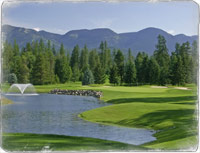WLGA History
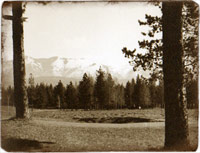 In those days money was hard to get and the course development became a slow process. These hard-working people had cleared the land for what was to become fairway number one and fairway number two as well as part of number three (present Woods Nine) when one of the local politicians came up with a program whereby grants could be received for municipalities to build emergency landing fields. The City applied for and received the grant to build the golf course/landing field. The property owners, golfers, donated the land to Flathead County on October 29,1933 which then transferred it to the City of Whitefish on January 15, 1934 with the stipulation that it would become a golf course for local golfers and double as an emergency landing strip. This was accomplished in 1935 with the funding coming via the Work Project Authority which also built the log clubhouse/terminal. The project was completed in 1937. Joe Monegan, a local logger, hauled the logs and directed the building of the historic log structure. Brad Seeley, a civil engineer, came to Whitefish from Helena to approve the final project. The Grand Opening Tournament was held on May 24, 1936. The golfers paid off the purchase price of the land, bought equipment and fixtures for the clubhouse through individual contributions as well as the sale of $25 personal bonds.
In those days money was hard to get and the course development became a slow process. These hard-working people had cleared the land for what was to become fairway number one and fairway number two as well as part of number three (present Woods Nine) when one of the local politicians came up with a program whereby grants could be received for municipalities to build emergency landing fields. The City applied for and received the grant to build the golf course/landing field. The property owners, golfers, donated the land to Flathead County on October 29,1933 which then transferred it to the City of Whitefish on January 15, 1934 with the stipulation that it would become a golf course for local golfers and double as an emergency landing strip. This was accomplished in 1935 with the funding coming via the Work Project Authority which also built the log clubhouse/terminal. The project was completed in 1937. Joe Monegan, a local logger, hauled the logs and directed the building of the historic log structure. Brad Seeley, a civil engineer, came to Whitefish from Helena to approve the final project. The Grand Opening Tournament was held on May 24, 1936. The golfers paid off the purchase price of the land, bought equipment and fixtures for the clubhouse through individual contributions as well as the sale of $25 personal bonds.
The original Whitefish Lake Golf Association was formed on March 30, 1934 with twenty-five cent annual membership dues. D. P. Dedon was elected as the first president and Dallas Stocking served as the initial secretary of the new association. The list of original members constitutes a virtual who’s who in Whitefish history with names like: L. A. Muldown, E. M. Hutchinson, Rusty Abell, R. H. Sloan, Ira Kell, R. F. Haines, John Lockridge, Dr. McClench, Charles Weller, K. B. Tate, Clark Forcum, Chas Tarr, Claude Brittlell, Bill Trippett, Louise Abell, and others as well. The Whitefish Lake Golf Association hired its first golf professional, Fred Hall, who helped finish the construction of the course as designed by Bill Trippett.
The City of Whitefish began operating the golf course, incurred debt and lost money at the same time. In the 1940’s the City considered closing the golf course when local golfers incorporated the Whitefish Lake Golf Association and leased the course from the City and also assumed the debt. From that time until the present the Whitefish Lake Golf Association has operated the course on a not-for-profit or break-even basis.
In the 1950’s the WLGA felt the need to expand the facility, and the Association bought the adjoining property necessary to add what was to become the Lake Nine.
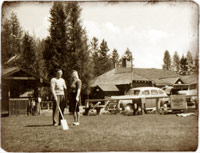 Dr. Don Brown and Brad Seeley arranged for the purchase of the land for $8,400 which was to be used to develop the additional nine holes. The land and the course development were paid for by the WLGA through personal loans from members and selling 10-year memberships. Whitney Smith was the chairman of the Lake Nine Development Project for the WLGA along with golf professional Roy Owens, Sterling Rygg, Mel Lane, Herb Peschel Sr. and H. O. Swisher serving on the committee. This property was developed into an 18-hole golf course during the early 1960’s and became very popular throughout the Northwest. Mr. G. A. MacMillan of Helena was hired to design the new addition that allowed the development to take place while play continued on the original nine holes. Most of the development work was done via volunteer workers and donated equipment but still cost the Association nearly $70,000 to complete. Numerous young golfers earned golf privileges by picking rocks off the fairways. In 1964 the WLGA purchased the original driving range for $7,000. That land is now part of the site of Grouse Mountain Lodge.
Dr. Don Brown and Brad Seeley arranged for the purchase of the land for $8,400 which was to be used to develop the additional nine holes. The land and the course development were paid for by the WLGA through personal loans from members and selling 10-year memberships. Whitney Smith was the chairman of the Lake Nine Development Project for the WLGA along with golf professional Roy Owens, Sterling Rygg, Mel Lane, Herb Peschel Sr. and H. O. Swisher serving on the committee. This property was developed into an 18-hole golf course during the early 1960’s and became very popular throughout the Northwest. Mr. G. A. MacMillan of Helena was hired to design the new addition that allowed the development to take place while play continued on the original nine holes. Most of the development work was done via volunteer workers and donated equipment but still cost the Association nearly $70,000 to complete. Numerous young golfers earned golf privileges by picking rocks off the fairways. In 1964 the WLGA purchased the original driving range for $7,000. That land is now part of the site of Grouse Mountain Lodge.
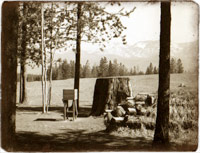 As the popularity of the 18-hole course grew, the WLGA began looking for ways to update the hand-operated irrigation system to one that was automated. In 1973-74, matching federal grants became available from the Bureau of Land Management and Recreation, whereby an agreement to donate the Lake Nine (LOT 4) to the City of Whitefish was reached that enabled the WLGA to upgrade the irrigation system. Roland Newton and others helped formulate this project. This agreement with the BOR called for the continued use of the property exclusively for golf with preference given to local golfers. In addition, the Whitefish Lake Golf Association helped the development of Grouse Mountain Park property across the highway spending $17,000 for tennis courts and the soccer fields.
As the popularity of the 18-hole course grew, the WLGA began looking for ways to update the hand-operated irrigation system to one that was automated. In 1973-74, matching federal grants became available from the Bureau of Land Management and Recreation, whereby an agreement to donate the Lake Nine (LOT 4) to the City of Whitefish was reached that enabled the WLGA to upgrade the irrigation system. Roland Newton and others helped formulate this project. This agreement with the BOR called for the continued use of the property exclusively for golf with preference given to local golfers. In addition, the Whitefish Lake Golf Association helped the development of Grouse Mountain Park property across the highway spending $17,000 for tennis courts and the soccer fields.
With the continued growth of golf in Whitefish, the existing 18-hole course was soon operating at near capacity. The population was growing with demand for golf exceeding availability in western Montana, so a group of local entrepreneurs bought property south of Highway 93 across from the existing course. This group, Grouse Mountain Development and headed by Tim Gratton, built an additional 9-holes that was called the Mountain Nine and completed in the early 1980’s. The Grouse Mountain Development principals leased the completed 9-holes to the Whitefish Lake Golf Association for one dollar per year for 75 years with a renewable option with the same terms. The property was covered by covenants that stated the only use of the land would be for golf course operation, with WLGA assuming all responsibility for maintenance, taxes, and all other operating costs. Throughout the 1980’s the course operated as a 27-hole facility. Also in the early 1980’s another group of golfers informed the Board that additional property was available to build another 9-holes to make Whitefish Lake Golf Course a 36-hole facility. The Board declined to exercise that option from Walt Nussbaum and Don Jensen due to a perceived lack of need.
The Association did, however, feel that a needed upgrade or remodel of the original 18-holes (North Course) was due to occur. Golf course architect John Steidel was hired and the remodel was accomplished in 1983 for the Woods Nine and in 1985 for the Lake Nine at a cost of nearly $750,000. The move proved extremely popular with the members and green fee players to the extent that often in order to obtain tee times two days in advance, a player would need to be in line by 4:30 a.m. It was then in the late 1980’s that the WLGA Board of Directors began the acquisition of land to add another 9-holes to form the South Course. Dick Maddux and Jim Welch were instrumental in the coordination of the seven different parcels obtained to build the additional 9-holes. The South Course development took four years to be built, grow in and finally open in June of 1994. The total cost of the additional 9-holes and remodel of the now incorporated Mountain Nine was $1,200,000. Golf course architect John Steidel was again engaged to design the addition and remodel phases of the expansion project. Terry Nelson guided the development of the newly created holes adjacent to Lost Loon Lake through all the permitting processes by working with the Corp of Engineers, EPA, US Fish and Game, County Permits, Wetland Delineation, Whitefish Lakeshore Protection Committee, Flood Plain oversight, the Lost Loon Lake Homeowners Association, and numerous individuals opposed to the expansion of the golf course.
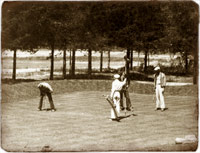 Unfortunately, five of the wettest years in Whitefish history occurred during the early 1990’s and sections of the South Course were flooded beyond playability in April of 1996. The WLGA returned to various agencies for permits in order to reclaim the flooded property. Raising the entire area adjacent to Lost Loon Lake by over 4 feet and rebuilding the affected fairways, greens and tees cost yet another $400,000. The South Course reopened in July of 1998. A new permit was granted to allow the course to regulate the level of Lost Loon Lake during periods of potential flooding. The targeted elevation of the lake was agreed to be 2004 feet above sea level.
Unfortunately, five of the wettest years in Whitefish history occurred during the early 1990’s and sections of the South Course were flooded beyond playability in April of 1996. The WLGA returned to various agencies for permits in order to reclaim the flooded property. Raising the entire area adjacent to Lost Loon Lake by over 4 feet and rebuilding the affected fairways, greens and tees cost yet another $400,000. The South Course reopened in July of 1998. A new permit was granted to allow the course to regulate the level of Lost Loon Lake during periods of potential flooding. The targeted elevation of the lake was agreed to be 2004 feet above sea level.
During the fall of 1999 the Whitefish Lake Golf Association completed a $620,000 restoration/upgrade project for the clubhouse. A totally new kitchen was added including new equipment purchased by the WLGA. The dining room added semi-private dining alcoves and the old kitchen was converted into a private dining area called the professional room. The golf shop was upgraded as was the bag room, club repair and bag storage areas. New locker rooms were added for both men and women and separate restrooms for the restaurant/lounge were established. The project included total replacement and upgrades of the mechanical systems for the entire building.
In 2003 Tim and Darlene Grattan generously donated the original Mountain Nine golf holes to the Whitefish Lake Golf Association which turned all of the South Course ownership over to WLGA. This was an extremely beneficial arrangement for the Whitefish Lake Golf Association going forward, and a plaque to commemorate the Grattans was placed near the first tee on the South Course.
In 2005 the irrigation system on the South Course was upgraded with wireless controllers and the North Course was upgraded with wireless controllers and new irrigation boxes. The parking lot entry was also upgraded with new rock columns constructed with enhanced lighting.
2006 brought the driving range upgrade including sodding the entire area plus the addition of target greens. New poles and netting were installed by Rocky Mountain Contractors making the range safer by better containing errant shots.
Holes 13 and 14 on the North Course were changed significantly in 2008 with the moving of the cart path below 13 green and new tees added to the 14th hole. This was one of the more significant changes to that section of the golf course. That same year the deck was rebuilt and the outside pavilion/bar was added creating an enormous increase in outside services. At the same time, the starter shack was moved to the south side of the Hole 1 tee complex and the cart path was also rerouted.
In the summer of 2010, a major bunker renovation project began that would last for several years. The cloth liners were replaced and sodded layers were used to line the bunkers. The cottonwood trees lining the Number 1 fairway on the South Course were removed to decrease the risk to players from shallow roots and prevent further damage to the cart paths in the area. The new green on Number 5 North was constructed and sodded. At the same time a new tee complex was built Number 6 on the North Course.
A new lease was negotiated with the City of Whitefish in 2010 by Paul Johannsen and Terry Nelson for the North Course. The new lease was written for a 30-year period with the option to renew for another 20 years making it effectively a 50-year lease.
In 2012 the club built the new Turf Center/maintenance area for a cost of roughly $1.2 million creating one of the premier facilities in the region. That same year several new cart paths were renovated.
In 2013 the Number 6 green was rebuilt and enlarged, and the flat roof of the clubhouse was replaced. Forward tee building was placed as a high priority and the gold tees were opened for seniors and those wishing to play a shorter course.
2015 saw newly shaped and sodded greens on Holes 1, 7 and 8 on the North Course and the forward tee project continued with at least nine new tees constructed.
In 2017 the North Course putting green was renovated and enlarged. Security lighting was added to the parking lot and around the putting green circle.
In 2019 the Turf Center annex was refurbished and the short game practice facility was added behind Number 1 green on the South Course. Another major project included the complete rebuild of the parking lots. This coincided with the completion of the Highway 93 renovation project by the Montana Department of Transportation.
The North Course pump house control panels were upgraded to more efficient and up-to-date computer controls in 2020.
During the 2021 season the panels for the pump house on the South Course were replaced to an upgraded operating system and controls. The new putting green on the South Course was constructed in its newly enlarged location.
In 2022 a new storage shed was built adjacent to the east side of the driving range to store teaching equipment and junior golf supplies. A gazebo for the starters on the South Course was also completed and the Number 11 South green was totally reshaped for playability.
In the fall of 2022, a demolition of the bag room area was completed and replaced in the same footprint with a two-story building that houses offices, a conference room and large deck on the upper level. The first floor of the renovated space contains three simulators, restrooms and a club repair area as well as rental club storage. The golf shop was completely renovated and reoriented with new carpet, walls, storage, changing rooms and more strategically located office space. The second phase of the renovation project will relocate the walk-in cooler/freezer and create a much larger work space for the kitchen staff. New hallways were created to make serving the deck, lounge and simulator areas with food and beverage much more efficient. The project was designed by lead architect Matt Lawrance from Montana Creative with Martel Construction running the building operations.
Throughout all of the time it has taken to build the Whitefish Lake Golf Club into the only 36-hole complex in Montana, the Golf Association and its Board of Directors have always operated on a volunteer basis. All of the monies generated from the operations have been put back into course improvement, equipment, other capital expenses or paid out to the City of Whitefish as lease payments. The goal of the WLGA is to continue its cooperative relationship with the City of Whitefish while maintaining the highest quality golf facility at an affordable price. A by-product of all of this growth and development of golf opportunity is the attraction of tourists to our area to play our golf courses and take advantage of other attractions in the area.
At no time in the history of the golf course development or improvements has taxpayer money been used for the golf course.
